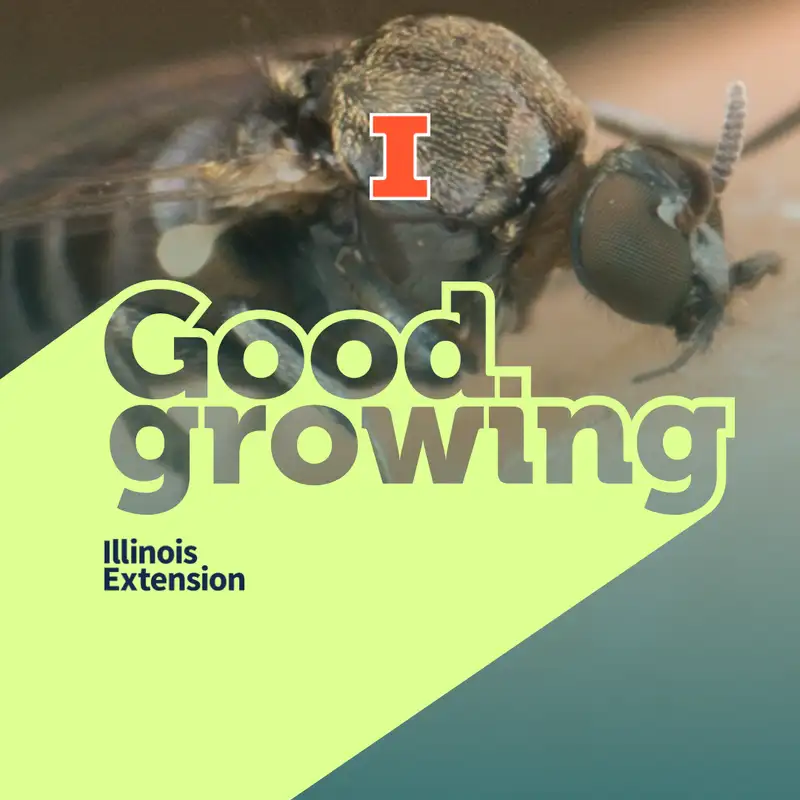Gardenbite: The life and bites of buffalo gnats | #GoodGrowing
Welcome to the Good Growing podcast. I am Ken Johnson, horticulture educator with University of Illinois Extension, coming to you today from Jacksonville, Illinois with a gardenbite. And on this week's Gardenbite, we're gonna talk a little bit about the dreaded buffalo gnats. So it's that time of year. We're in mid May here, it's time for buffalo gnats to be arriving in our landscapes.
Ken Johnson:If you've spent much time outdoors this time of year, there's a good chance you've had an encounter with buffalo gnats. And if it seems like there are more buffalo gnats nowadays than there were back in the day, so to speak, it's likely due to the fact that we have cleaner bodies of water. Since we've been cleaning up our our waterways, the water's becoming cleaner, we have seen an increase in the population of buffalo gnats. So what exactly are buffalo gnats? So these are also known as black flies, and they belong to the family simuliidae.
Ken Johnson:They're small, about sixteenth to one eighth of an inch long humpback flies. They have humps, on their back in the thorax area that resemble the hump of a buffalo or a bison. This is how they get their their common names. Both the males and the females are going to feed on nectar, and other sugar sources, like plant sap and honeydew, insect honeydew, things like that. However, just like mosquitoes, do and ticks, the females need to feed on blood in order to produce eggs.
Ken Johnson:And the females are going to use their scissor like mouthparts to bite, and this can cause a painful, and cause itching and swelling and red welts, and allergic reactions in some people due to the fly's saliva, again, similar to mosquitoes. In addition to their painful bites on humans, buffalo nest can also or also have been known to kill poultry and other birds. If populations get really high, the toxins from their bites can kill the birds, and they can also just be so numerous that they can actually suffocate the birds themselves. They get clogged, in their noses and stuff, they and they can't breathe. Buffalo nets will also feed on other, animals, warm blooded animals as well, so feed on the thin haired areas of dogs and cats, horses, like the ears, undersides, things like that.
Ken Johnson:About 12 different species of buffalo gnats can be found in Illinois. Not all of them are going to feed on humans necessarily though. Some of them may only feed on a few types of animals. However, there are no species of buffalo gnats that feed exclusively on humans. They'll feed on other animals, as well.
Ken Johnson:So when it comes to the life cycle of buffalo gnats, after mating and feeding on a blood meal, the females are going to begin to lay eggs. A lot of times this is going to be in or near running water. Some other species will also attach their eggs to wet surfaces, like the blades of leaves or on debris in the water. Depending on the species, they're capable of laying between a 5,500 eggs over the lifetime, each female buffalo gnat. Many species of buffalo gnats are going to overwinter as eggs, but there are some that will overwinter, as larvae in the water.
Ken Johnson:After hatching, the spindle shaped larvae will attach themselves to rocks or other submerged items, using silk that they will produce. And the larvae are going to need flowing water in part because they are filter feeders. So they're gonna use these fan like structures called labral fans. These are on their head and they're gonna use them to capture food, things like algae, bacteria, pollen, other organic matter that may be, in the water. Eventually, well, when the time comes, the larvae will spin a cocoon underwater and they will pupate.
Ken Johnson:And then when the adults are ready to emerge, they will rise to the surface on a bubble of air, and most the adults of most species are going to be active from mid May to July, again, depending on the species and where you are at, in the country or in the state. Adult buffalo nests are capable of flying 10 or more miles in search of a blood mill, but they're going to be most commonly encountered close to the water sources that they are developing in. Usually fly about half a mile or so. Buffalo gnats are going to be attracted to carbon dioxide, exhaled by humans, other animals, their prey, as well as sweat, and dark moving objects. Again, similar to mosquitoes and ticks do, but they're all feeding on warm blooded vertebrates.
Ken Johnson:Buffalo gnats are going to be most active on calm days, usually just after sunrise and just before sunset, so those dusk and dawn time frames there. Individual adults can live for a couple for several weeks, but fortunately, once water temperatures start to reach the mid seventies, eggs stop hatching, adult and the adult populations will begin to decline, again, as that weather starts warming up quite a bit. The number of generations that buffalo gnats will have in a year is again gonna depend on the species. Some may only have one generation, others may have multiple generations per year though. So when it comes to, avoiding buffalo gnats and avoid being biting, there's there's several different things we can do.
Ken Johnson:One thing we can't really do though is try to control buffalo net populations themselves. Because, again, these are developing in flowing water or water and and flowing water in addition to that, And there are very strict regulations about applying pesticides to moving bodies of water. So controlling the larvae of buffalo gnats is going to be impractical. Any pesticides that were going to be used are gonna have negative effects on other aquatic life, other insects, fish, things like that. And this would need to be done as an an area wide, management program.
Ken Johnson:You couldn't just do a section of a stream or section of of a river or something like that. You need to do the whole area to really get good control. So in addition to not really being legal, it's also impractical to try to manage the larvae, of buffalo gnats. Fogging areas for buffalo gnats isn't going to provide effective long term management either. Just like mosquitoes, they will eventually, move back into the air.
Ken Johnson:So it's more of a temporary fix than anything else. So instead of trying to get rid of the buffalo gnats, we should try to prevent being bitten by them. So there's, again, several ways we can do this. We wanna avoid infested areas, especially when they're most active. Again, this is going to be early in the morning or at dusk.
Ken Johnson:So try to prevent areas near water where buffalo gnats are present. We're just go try to avoid going outdoors at that time. Like mosquitoes, buffalo nets are not particularly strong flyers. So if you're using if you're gonna be outdoors, using fans, can help reduce bites from them as well. We also wanna try to cover, our skin as much as possible to reduce reduce the number of bites that we may get.
Ken Johnson:So wearing long pants, long sleeve shirts. If you have the option or the ability to, wearing clothing that has zippers instead of buttons, zippers are gonna be better than buttons at keeping buffalo nets from getting inside of clothing. And again, since they are attracted to dark objects, try to wear light colored clothing. And if you live in an area where there where buffalo gnats are particularly prevalent, populations are really high, wearing head nets may be helpful as well. So again, lot of things we're doing for mosquitoes and ticks are also going to be effective for avoiding being bitten by buffalo gnats.
Ken Johnson:Also, using repellents, is going to be effective as well. So things containing DEET can be effective, at repelling buffalo gnats as well. And many people have reported, that vanilla can be fairly effective as a repellent as well. There hasn't been a whole lot of research on this, but anecdotally, many people say that vanilla can be, an effective scent at repelling them as well. But fortunately, unlike mosquitoes, buffalo gnats aren't going to bite through clothing, so only exposed skin is is going to be potentially attacked by them.
Ken Johnson:Well, that's all I've got for you for this week's Garden Bites. Thanks for listening. We'll be back next week with another good growing podcast episode. Listeners, thank you for doing what you do best and that is listening or if you're watching us on YouTube watching. And as always, keep on growing.
Creators and Guests


